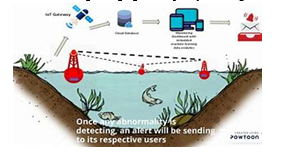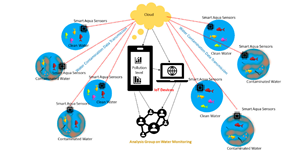Ijraset Journal For Research in Applied Science and Engineering Technology
- Home / Ijraset
- On This Page
- Abstract
- Introduction
- Conclusion
- References
- Copyright
Environmental Monitoring in Internet of Things (IOT)
Authors: Mrs. C. Radha, Mr. M. Madheswaran, Mr. M. Lokesh, Mr. M. Mohammad Althaf
DOI Link: https://doi.org/10.22214/ijraset.2024.60086
Certificate: View Certificate
Abstract
The Internet of Things (IoT) connects physical objects to the internet, enabling autonomous data collection and analysis. In environmental monitoring, IoT plays a crucial role in gathering real-time data on parameters like air and water quality, weather, wildlife behavior, and urban heat islands. This abstract explores how IoT is used in environmental monitoring, covering standards, device types, and applications. IoT comprises interconnected devices that collect environmental data and transmit it for analysis, facilitating continuous observation and better resource management. Standards like MQTT and communication technologies like Wi-Fi govern IoT implementation. Environmental monitoring involves assessing air and water quality, weather conditions, wildlife behavior, and urban heat islands. Air quality monitoring measures pollutant levels in the atmosphere using IoT-based sensor networks. Water quality monitoring assesses chemical and biological characteristics of water bodies. Weather and climate monitoring observe atmospheric conditions using IoT-based sensor networks. Wildlife monitoring tracks animal movements and behavior using IoT-enabled devices. Urban heat island monitoring assesses temperature distribution in urban areas using IoT-based sensors. IoT revolutionizes environmental monitoring by enabling real-time, remote observation across various domains, contributing to better resource management and sustainability efforts.
Introduction
I. INTRODUCTION
The Internet of Things (IoT) revolutionizes environmental monitoring by connecting physical objects to the internet, allowing them to autonomously collect, exchange, and analyze data. In this context, IoT serves as a crucial tool for gathering real-time information on various environmental parameters, including air and water quality, weather conditions, wildlife behavior, and urban heat islands. By leveraging IoT technology, stakeholders can gain timely insights into environmental dynamics, facilitating informed decision-making and policy formulation for environmental conservation and sustainability. This deep abstract aims to explore the multifaceted applications of IoT in environmental monitoring, discussing the standards, types, and methodologies associated with each domain to elucidate its transformative potential.
The Internet of Things (IoT) represents a transformative concept wherein physical objects are interconnected through the internet, empowering them to collect, share, and interpret data independently. This connectivity extends to environmental monitoring, where IoT assumes a pivotal role in obtaining real-time information regarding diverse environmental factors. These encompass air and water quality, meteorological conditions, wildlife activities, and urban heat island phenomena. This deep abstract endeavors to delve into the multifaceted applications of IoT within the realm of environmental monitoring, elucidating the standards, classifications, and approaches pertinent to each facet
II. IOT STANDARDS
IoT standards encompass communication protocols and data formats that govern how devices interact and exchange data within IoT ecosystems. Communication protocols, such as MQTT, CoAP, and HTTP, dictate how devices communicate over networks, considering factors like bandwidth and device constraints. These protocols enable efficient data transmission and ensure interoperability between diverse IoT devices. Additionally, standards define data formats like JSON and XML, providing a common structure for representing and transmitting information between devices and applications. By adhering to these standards, IoT systems can seamlessly integrate devices from different manufacturers and facilitate the exchange of data, ultimately fostering interoperability, scalability, and reliability in IoT deployments.
The Internet of Things (IoT) refers to the network of interconnected devices embedded with sensors, software, and other technologies to collect and exchange data over the internet. These devices can range from everyday objects like household appliances and wearable devices to industrial machines and infrastructure components.
- Sensors and Actuators: These are the components that collect data from the environment (sensors) or perform actions based on that data (actuators).
- Connectivity: IoT devices are connected to the internet or other networks, allowing them to communicate with each other and with central systems.
- Data Processing and Analytics: The data collected by IoT devices is processed and analyzed to extract meaningful insights, enabling informed decision-making and automation.
- Automation and Control: IoT systems can automate processes and control devices remotely based on the data they collect, improving efficiency and responsiveness.
- Applications: IoT technology finds applications across various domains, including smart homes, healthcare, transportation, agriculture, manufacturing, and environmental monitoring, among others.
IoT has the potential to revolutionize industries, enhance convenience in daily life, and drive innovation by enabling new services and business models. However, it also raises concerns related to privacy, security, and data governance that need to be addressed as the technology continues to evolve.
III. ENVIRONMENTAL MONITORING
Environmental monitoring is the systematic observation and measurement of various environmental parameters to assess their quality, health, and impact on ecosystems and human health. This includes monitoring parameters such as air and water quality, weather conditions, soil health, biodiversity, and pollution levels. By collecting and analyzing data on these factors, environmental monitoring helps us understand environmental trends, identify potential risks, and make informed decisions regarding resource management, conservation efforts, and public health initiatives. It plays a critical role in assessing the effectiveness of environmental policies and regulations and in mitigating the impact of human activities on the environment. Overall, environmental monitoring aims to promote sustainable development and protect natural ecosystems for present and future generations.
Environmental monitoring is the process of systematically observing and measuring various aspects of the environment to assess its health and quality. This includes monitoring parameters such as air and water quality, weather conditions, soil health, biodiversity, and pollution levels. By collecting and analyzing data on thesefactors, environmental monitoring helps us understand environmental trends, identify potential risks, and make informed decisionsregarding resource management, conservation efforts, and public healthinitiatives.It plays a critical role in ensuring the sustainability of ecosystems and safeguarding human health and well-being in a changing world.
The Environmental Monitoring Are Different Types,
- Air Quality Monitoring
- Water Quality Monitoring
- Weather and Climate Monitoring
- Wildlife Monitoring
- Urban Heat Island Monitoring
IV. AIR QUALITY MONITORING
Air quality monitoring in IoT projects involves the use of interconnected sensors and devices to continuously measure various pollutants and environmental factors in the air. These sensors can detect pollutants such as particulate matter (PM2.5, PM10), nitrogen dioxide (NO2), sulfur dioxide (SO2), carbon monoxide (CO), ozone (O3), and volatile organic compounds (VOCs). The data collected by these sensors is transmitted to central servers or cloud platforms where it is analyzed in real-time. This information is then used to assess air quality levels, identify sources of pollution, and provide actionable insights for improving public health and environmental quality. IoT-based air quality monitoring systems enable authorities and communities to make informed decisions regarding pollution control measures, urban planning, and public health interventions.

IoT devices equipped with sensors for measuring air pollutants such as particulate matter (PM2.5, PM10), nitrogen dioxide (NO2), sulfur dioxide (SO2), carbon monoxide (CO), and ozone (O3) are deployed across cities and industrial areas. These devices continuously monitor air quality levels and provide real-time data to authorities and the public. For example, the "BreezoMeter" platform aggregates data from various air quality sensors to create detailed air quality maps and provide personalized health recommendations to users.
V. WATER QUALITY MONITORING
Water quality monitoring involves the systematic assessment of various physical, chemical, and biological parameters in water bodies to evaluate their suitability for different uses, such as drinking, recreational activities, and aquatic habitat support. This process typically includes measuring factors such as pH, dissolved oxygen, turbidity, temperature, nutrient levels (e.g., nitrogen and phosphorus), heavy metal concentrations, and the presence of pathogens and pollutants. Monitoring data helps identify potential sources of contamination, assess trends over time, and inform management and regulatory decisions aimed at protecting water resources and ensuring public health. Water quality monitoring plays a crucial role in safeguarding ecosystems, supporting sustainable water management practices, and addressing emerging water quality challenges.

IoT sensors are deployed in bodies of water such as rivers, lakes, and oceans to monitor parameters like pH levels, dissolved oxygen, temperature, turbidity, and concentrations of pollutants like heavy metals and nutrients. This data helps in assessing water quality, detecting pollution sources, and managing water resources. One example is the "SmartBay" project in Galway Bay, Ireland, where IoT sensors monitor various oceanographic parameters to support marine research, aquaculture, and environmental monitoring efforts.
VI. WEATHER AND CLIMATE MONITORING
Weather and climate monitoring involves the continuous observation and measurement of atmospheric conditions and climate patterns to understand short-term weather phenomena and long-term climate trends. This process includes collecting data on parameters such as temperature, humidity, precipitation, wind speed and direction, atmospheric pressure, and solar radiation. Weather monitoring provides real-time information for weather forecasting, disaster preparedness, and aviation and maritime operations. Climate monitoring focuses on long-term trends, analyzing historical data to assess climate variability, identify climate change impacts, and inform adaptation and mitigation strategies. Both weather and climate monitoring are essential for supporting various sectors, including agriculture, transportation, energy, and public health, and for enhancing resilience to climate-related risks and hazards.

IoT devices equipped with weather sensors are deployed in various locations to monitor weather conditions such as temperature, humidity, wind speed, and precipitation. These devices provide real-time weather data for forecasting, disaster preparedness, and climate research. For instance, the National Oceanic and Atmospheric Administration (NOAA) operates a network of weather stations equipped with IoT sensors to monitor weather conditions across the United States.
VII. WILDLIFE MONITORING
Wildlife monitoring involves the systematic observation and tracking of animal populations, behaviors, and habitats in their natural environments. This process utilizes various techniques such as GPS tracking, radio telemetry, camera traps, and acoustic monitoring to collect data on wildlife movements, distribution patterns, reproductive behaviors, and interactions with their surroundings. Wildlife monitoring helps scientists, conservationists, and policymakers gain insights into wildlife populations' health, dynamics, and ecological roles. By understanding wildlife behaviors and habitat preferences, monitoring efforts contribute to conservation efforts, biodiversity management, and the protection of endangered species. Wildlife monitoring also plays a crucial role in assessing the effectiveness of conservation initiatives, habitat restoration projects, and wildlife management strategies. Overall, wildlife monitoring is essential for promoting biodiversity conservation, preserving ecosystems, and ensuring the long-term sustainability of natural habitats.

IoT devices such as GPS trackers, motion sensors, and cameras are used to monitor wildlife populations, track animal movements, and study behavior patterns. This data helps in wildlife conservation efforts, habitat management, and mitigating human-wildlife conflicts. For example, the "Instant Wild" project uses IoT-enabled camera traps to monitor wildlife populations in various habitats around the world and engage citizen scientists in wildlife conservation efforts.
VIII. URBAN HEAT ISLAND MONITORING
Urban heat island (UHI) monitoring involves the observation and analysis of temperature variations within urban areas compared to their surrounding rural environments. Urban areas typically experience higher temperatures due to factors such as the heat-absorbing properties of buildings and roads, reduced vegetation cover, and human activities. UHI monitoring utilizes temperature sensors and thermal imaging technology to measure surface and air temperatures across urban landscapes. By analyzing UHI patterns, researchers and urban planners can identify areas of high heat intensity, understand the factors contributing to UHI formation, and develop strategies to mitigate heat-related risks and improve urban livability. UHI monitoring is essential for informing urban planning decisions, implementing green infrastructure initiatives, and addressing heat-related health impacts in densely populated cities.

IoT sensors are deployed in urban areas to monitor surface temperatures and assess the extent of urban heat islands (areas with higher temperatures compared to surrounding rural areas). This data helps urban planners and policymakers implement strategies to mitigate heat island effects and improve urban livability. One example is the "Urban Observatory" project in Newcastle, UK, which uses IoT sensors to monitor various environmental parameters, including temperature, across the city.
IX. ADVANTAGES OF ENVIRONMENTAL MONITORING
- Early Detection of Environmental Hazards: Monitoring allows for the early detection of environmental hazards such as pollution events or natural disasters, enabling timely response measures to mitigate risks and minimize damage.
- Informed Decision-Making: Monitoring provides valuable data and insights into environmental conditions, trends, and potential risks, empowering policymakers, regulators, and stakeholders to make informed decisions regarding resource management, conservation efforts, and public health initiatives.
- Protection of Ecosystems and Biodiversity: By tracking environmental parameters such as air and water quality, soil health, and biodiversity, monitoring helps identify areas of concern and implement measures to protect and preserve natural ecosystems and species diversity.
- Public Health Benefits: Environmental monitoring contributes to the protection of public health by identifying sources of pollution and potential health hazards, enabling authorities to implement measures to reduce exposure and safeguard community well-being.
- Regulatory Compliance: Monitoring ensures compliance with environmental regulations and standards by providing data to assess environmental performance, track progress, and demonstrate adherence to legal requirements.
X. DISADVANTAGES OF ENVIRONMENTAL MONITORING
- Cost: Establishing and maintaining monitoring networks can be costly, requiring investment in equipment, infrastructure, personnel, and data management systems.
- Complexity: Environmental monitoring involves dealing with complex interactions and dynamics within ecosystems, making it challenging to interpret data accurately and identify cause-effect relationships.
- Technological Limitations: Monitoring technologies may have limitations in terms of accuracy, precision, sensitivity, and coverage, impacting the reliability and comprehensiveness of monitoring data.
- Data Interpretation Challenges: Interpreting monitoring data requires specialized knowledge and expertise in environmental science, statistics, and data analysis techniques, posing challenges for non-specialists in understanding and utilizing the information effectively.
- Incomplete Coverage: Monitoring networks may have gaps in coverage, particularly in remote or inaccessible areas, limiting the scope and representativeness of monitoring data and hindering comprehensive assessments of environmental conditions. While environmental monitoring offers numerous benefits for environmental protection and public health, addressing its challenges and limitations is essential for maximizing its effectiveness and ensuring sustainable management of natural resources and ecosystems.
Conclusion
In conclusion, environmental monitoring IoT projects play a crucial role in addressing pressing environmental challenges by providing real-time data and insights into air and water quality, weather patterns, wildlife behavior, and urban heat islands. These projects leverage the capabilities of IoT devices and sensors to collect vast amounts of environmental data, enabling authorities, researchers, and communities to make informed decisions and take proactive measures to protect the environment and public health. By harnessing the power of IoT technology, environmental monitoring initiatives contribute to sustainable development, conservation efforts, and resilience against climate change impacts. As technology continues to advance, the integration of IoT into environmental monitoring will likely become even more sophisticated, offering greater potential for addressing complex environmental issues and safeguarding the planet for future generations. IoT technologies have revolutionized environmental monitoring by enabling the continuous, remote, and data-driven observation of environmental parameters across various domains, including air and water quality, weather and climate, wildlife behavior, and urban heat islands. By leveraging IoT solutions, stakeholders can gain valuable insights into environmental dynamics, leading to more effective resource management, pollution control, and climate resilience strategies, ultimately fosteringsustainability and enhancing the quality of life for present and future generations.
References
[1] Dorsemaine Bruno, Gaulier Jean-Philippe, Wary Jean-Philippe, Kheir Nizar, Urien Pascal, Internet of Things: a definition and taxonomy, IEEE 9th International Conference on Next Generation Mobile Applications, Services and Technologies, 2015, Cambridge, UK, DOI: 10.1109/NGMAST.2015.71 URL: http://ieeexplore.ieee.org/abstract/document/7373221/ [2] Farooq, M. U., Waseem, M., Khairi, A., & Mazhar, S. (2015). A critical analysis on the security concerns of internet of things (IoT). International Journal of Computer Applications, 111(7). [3] Ying Zhang, Technology Framework of the Internet of Things and Its Application, in Electrical and Control Engineering (ICECE), 2011, pp. 4109-4112 [4] Ying Zhang, Technology Framework of the Internet of Things and Its Application, in Electrical and Control Engineering (ICECE), 2011, pp. 4109-4112 [5] Shi Yan-rong, Hou Tao, Internet of Things key technologies and architectures research in information processing in Proceedings of the 2nd International Conference on Computer Science and Electronics Engineering (ICCSEE), 2013 [6] https://www.epa.gov/monitoring. [7] https://www.climate.gov/. [8] https://www.unep.org/explore-topics/environmental-data-and-reporting/what-we-do/environmental-monitoring) [9] https://www.eea.europa.eu/data-and-maps. [10] https://waterdata.usgs.gov/.
Copyright
Copyright © 2024 Mrs. C. Radha, Mr. M. Madheswaran, Mr. M. Lokesh, Mr. M. Mohammad Althaf. This is an open access article distributed under the Creative Commons Attribution License, which permits unrestricted use, distribution, and reproduction in any medium, provided the original work is properly cited.

Download Paper
Paper Id : IJRASET60086
Publish Date : 2024-04-10
ISSN : 2321-9653
Publisher Name : IJRASET
DOI Link : Click Here
 Submit Paper Online
Submit Paper Online

